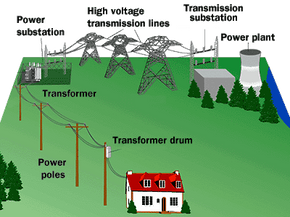The Transmission Substation
The three-phase power leaves the generator and enters a transmission substation at the power plant. This substation uses large transformers to convert or "step up" the generator's voltage to extremely high voltages for long-distance transmission on the transmission grid. Typical voltages for long distance transmission are in the range of 155,000 to 765,000 volts. The higher the voltage, the less energy is lost due to resistance [source: UCSUSA].
A typical maximum transmission distance is about 300 miles (483 kilometers). High-voltage transmission lines are quite obvious when you see them. They are huge steel towers strung out in a line that stretches toward the horizon.
Advertisement
All high-voltage towers have three wires for the three phases. Many towers also have extra wires running along the tops of the towers. These are ground wires and are there primarily in an attempt to attract lightning.
